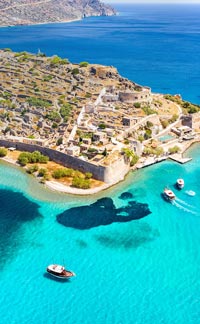Falassarna was a major ancient port city on the northwest coast of Crete. It minted its own coins stamped with a trident on one side and the first two letters (FA or ΦΑ) of the city's name on the obverse. There was the city which arose around the harbor, the only enclosed harbor on Crete's western shore, and an acropolis overlooking the harbor and the city.
Visible ruins are from the 300's BC and include towers and walls made of sandstone and the harbor enclosed on three sides by the city walls. The harbor, which was a deep inland lagoon, was connected to the sea by a pair of man-made channels 50 meters long and 2 meters deep. The city walls did double duty as protective harbor moles extending away from the city along the channels, making the city and harbor very secure. The quays along the harbor are stone-paved, with mooring stones. Warehouses, an alter, a bath, and roads have been excavated, many of them recently, from work begun in 1986. The channels and the harbor are now dry ground anywhere from 4 to 6 meters above sea level.
There is an acropolis on a cape jutting into the sea 300 meters to the west. Ruins have been found on its 90 meter-tall summit. There are ruins of a temple dedicated to Britomartis, the Cretan version of Artemis, goddess of the hunt, as well as watchtowers, wells and cisterns.
Falassarna, which was named after a local nymph who had heroic attributes, reached its acme during the 4th and 3rd centuries BC, although people had been living close to the sea since at least Minoan (ca 2000 BC) times. Falassarna allied herself with Kydonia (Chania), Knossos, and other cities against Phaistos and allied cities including Polyrrhenia. They fought for 100 years, until hostilities were called to a halt by the Roman Commissioner Appius Claudius. Polyrrhenia was considered victorious.
The city thrived because, geographically, it had direct access to Egypt and Alexandria. Sailors not only engaged in trade, however. They also engaged in piracy, which would prove to be the fall of the city. It was destroyed by the Romans in 69 AD. The Romans used huge blocks of stone to choke the harbor entrance off to all but the smallest boats, provoking a complete collapse of Falassarna's trade. A subsequent earthquake (365 AD) raised western Crete an average of 7.5 meters, stranding the city and harbor 100 meters from the sea.
Over the centuries the buildings crumbled, and the city was buried. It was re-discovered in the late 1800's by British travelers. Excavations in earnest began in 1986 under the supervision of the Greek Ministry of Culture.
A kilometer and a half south is the modern settlement, which has a number of popular, highly rated beaches.






















